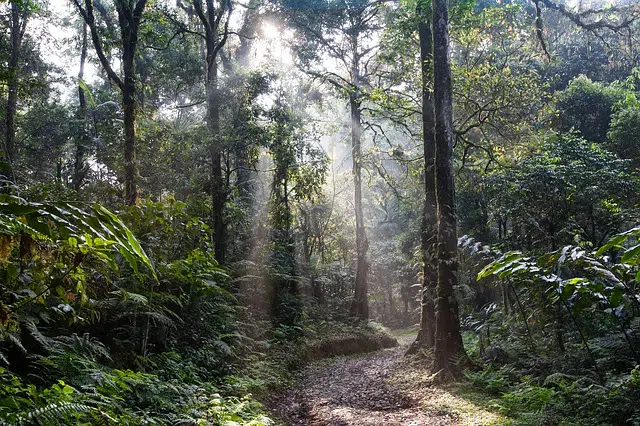
The jungle is characterized by the density of its vegetation.
Jungle , from the Latin silva , is an extensive area full of trees . It is a biome with very dense vegetation , with a wide variety of species. The concept changed over time : currently, the notion of jungle is associated with tropical forests , which develop in warm and humid areas.
Jungles can range from trees over 20 meters high to molds and mosses at ground level. They have, therefore, a high biodiversity (small number of specimens of the same species in each surface unit). On the other hand, environmental conditions cause jungles to retain a large amount of fresh water.
Jungles are often mentioned as the green lungs of the world since their mass of trees absorbs carbon dioxide and releases oxygen into the atmosphere. The deforestation of forests, for this and other reasons, constitutes a serious environmental problem. It is estimated that almost 30% of the oxygen we breathe comes from the jungles.
Types of jungle
There are several types of jungle:
* the humid , shade-loving or equatorial is found around the equator and the humid tropics, characterized by tall, dense vegetation and high levels of precipitation;
* the mountain or cloud appears between 1,000 and 2,200 meters of altitude;
* The tropophilous or dry type has trees that lose their leaves in periods of drought;
* the gallery surrounds the rivers ;
* the trade wind is influenced by the trade winds.

The high number of trees is a characteristic of the jungle.
Some characteristics of these regions
The climate of the tropical rainforest is humid tropical; that of the seasonal or monsoon forest, monsoon; that of the dry jungle, dry tropical. Regarding temperature , in the tropical forest it ranges between 27 °C and 29 °C, while the subtropical and montane forests have averages of 22 °C and 18 °C, respectively.
The average annual rainfall ranges from 1500 to 3000 mm, with the possibility of exceeding them. In the jungle of Ecuador, for example, rain is recorded every month, which has a direct impact on the characteristics of its rivers, which are short in length but very large; Although some years the average water level is less than expected, it is always sufficient for the subsistence of its vegetation. On the other hand, some areas suffer from droughts , which affect the variety and richness of their species; Others have well-defined seasons, as is the case of subtropical forests.
The soils have a moderate depth and their acidity is counterproductive for agriculture, analyzed from the point of view of temperate zones. On the other hand, the species typical of the jungles see no problem in developing; some of them have adapted to not need any type of land in particular. Likewise, given the shallow depth, trees keep a large part of their roots above the surface. All the wonderful biodiversity present in the jungles knows how to efficiently use the energy of the sun, temperature and water.
Jungle and biodiversity
There is no biome with a greater variety of plant and animal organisms than the jungle. It is worth mentioning, on the other hand, that there are few medium and large animal species , such as the puma and the jaguar, which are found in certain very specific areas.
It is worth highlighting the intelligence of leaf-cutter ants (the main herbivores of many of the jungles of South America), which take the pieces of plants to the subsoil in large numbers so that they are fermented and serve as nutrients for microorganisms, bacteria and mushrooms, the latter being their food source.
